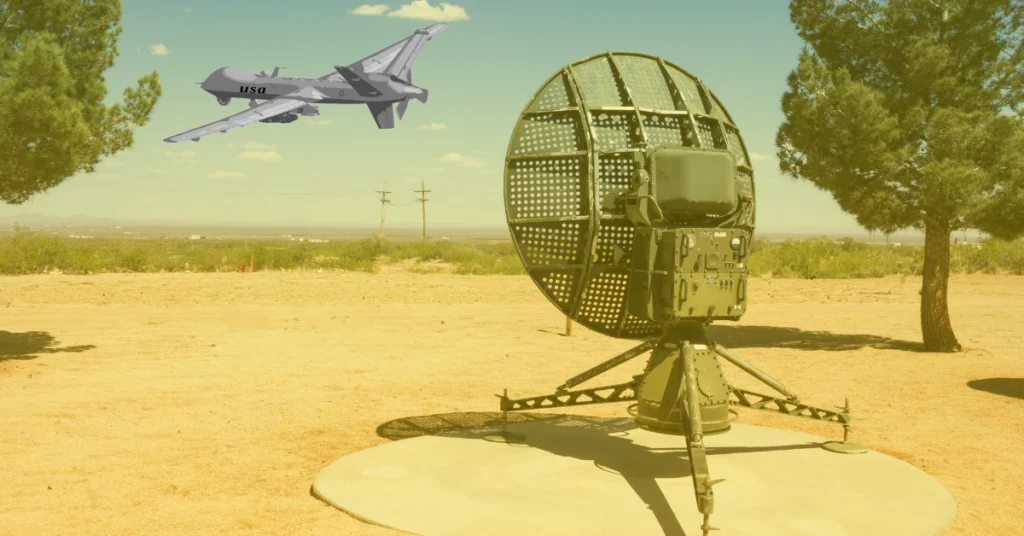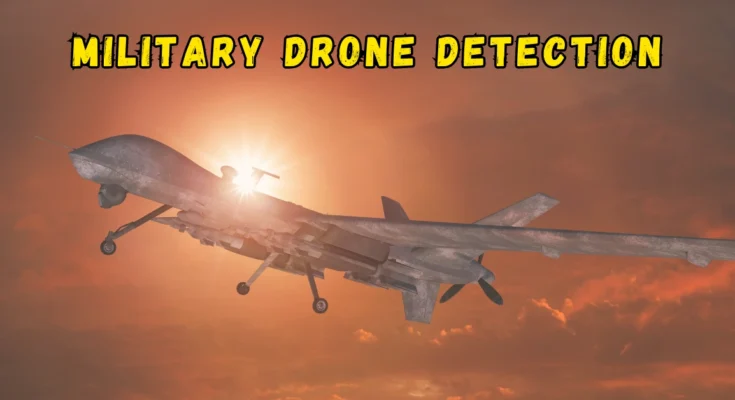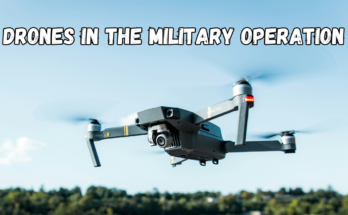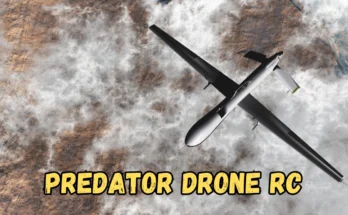Introduction:
Military drone detection in modern times when skies have been opened up for more than birds and planes is of great importance to national security and defense.
With more advancement of drones as effective tools for surveillance and war fares, it is no longer an option, but a necessity to ensure detection and countering these unmanned threats. This guide examines the sophisticated means and methods through which armed forces neutralize air-born threats posed by such unmanned vehicles.
We shall discuss the various elements of drone detection and countermeasures in detail from understanding the fundamentals of a counter-drone technology to comprehending the present day advanced detectors & countermeasure systems that protect our skies.
Let’s engage in a journey through the intricate domain of military drone detection, encompassing intelligence with creativity for security purposes.
Understanding Counter-Drone Technology
In the world we live in drones are being widely used in sectors such, as military, commercial and recreational. As a result there is an increasing need for technology to counteract the threats they pose. This section offers an exploration of counter drone technology including its definition, components and its importance in military applications.
Understanding Counter Drone Technology:
Counter drone technology also known as Counter Unmanned Aerial Systems (C UAS) encompasses a range of systems and methods that are specifically designed to identify, track and neutralize vehicles (UAVs) that may pose a security risk. In operations particularly this technology plays a role, in safeguarding sensitive areas and critical infrastructure against any unauthorized or hostile drone activities.
Components of Counter Drone Systems:
Counter drone systems typically consist of two components; detection and mitigation.
Detection of Drones:
Drones can be detected using systems that rely on methods. One such method is radar, which capable of detecting drones by scanning for their presence. Radar systems are effective, for long range detection. Can operate in weather conditions.
Another method is the use of radio frequency (RF) analyzers, which detect the communication signals between a drone and its controller.
This approach not helps in identifying the type of drone. Also provides information about its location. Acoustic sensors offer another detection method by picking up the sound signatures of drones. These various detection systems enable identification and monitoring of drones, in scenarios.
Mitigation:
When a drone is detected the next step is to neutralize it. There are methods to achieve this.
Signal Jamming:
Using RF jammers to disrupt the communication, between the drone and its controller compelling it to either land or return to its original starting point.
GPS Spoofing:
Manipulating the drones GPS system in order to divert its intended course.
Kinetic Methods:
Physically intercepting the drone by means of nets or other projectiles.
Significance in Military Applications:
The importance of counter technology in military settings cannot be emphasized enough. It serves a number of purposes.
Asset Protection;
Safeguarding bases, personnel and equipment from surveillance or attacks carried out by enemy drones.
Airspace Security;
Ensuring the security of locations by protecting their airspace.
Intelligence Gathering:
Disabling enemy drones as a means of preventing intelligence leaks or gathering information from captured drones.
Evolving Solutions;
The field of counter drone technology faces challenges.
Rapid Advancements, in Drone Technology:
As drones continue to advance countermeasures must also evolve accordingly.
Diverse Threat Profiles;
Drones come in sizes possess capabilities and serve different purposes. This necessitates detection and mitigation strategies.
Legal and Ethical Considerations;
Implementing counter drone measures in areas raises important legal and ethical questions.
To tackle these challenges researchers and developers are continuously working on finding solutions. The future of counter drone technology relies on the integration of intelligence, machine learning and automated systems to improve the accuracy of detection and response time.
It is crucial to understand counter drone technology in order to grasp the dynamics of warfare. With drones becoming increasingly prevalent, in operations it is essential to develop and deploy measures to counter them.
This not neutralizes threats but also strengthens defenses making it a vital component, in contemporary military strategies.
Advanced Drone Monitoring and Detection Methods
The key, to defending against drones is the accurate detection and monitoring of these airborne threats. Over time advanced methods for monitoring and detecting drones have greatly evolved, providing a variety of solutions to identify hostile aerial vehicles (UAVs) in different situations.
This section delves into these technologies and their significance, in military drone detection strategies.
Radar Systems: The Frontline of Drone Detection:
Radar systems play a role, in detecting objects especially drones even when they are several kilometers away. These systems work by sending out radio waves that bounce off objects in the air including drones and then return to the radar system. By analyzing these signals the radar system can determine where the object is located, how fast its moving and its trajectory.
High Resolution Radar:
radar systems used by the military have capabilities that allow them to accurately distinguish between drones and other small flying objects like birds. They provide information with resolution.
360 Degree Coverage:
Advanced radar systems offer coverage by scanning all directions. This is vital, for monitoring the airspace
Radio Frequency (RF) Analysis: Unraveling Communications
RF analysis is another critical method for drone detection. By monitoring the electromagnetic spectrum, these systems can detect the communication signals between a drone and its controller.
Identifying Signals:
RF analyzers have the ability to detect and identify the signals emitted by drones. This not helps in detecting their presence. Also provides valuable intelligence, about the type of drone and its capabilities.
Real Time Tracking:
These systems allow for real time tracking of drones providing information on their location and movement patterns.
Acoustic Sensors – The Silent Observers
Acoustic sensors serve as a layer in drone monitoring strategies. These devices are designed to pick up signatures produced by drones, which can be differentiated from other background noises.
Discreet Operations:
Acoustic sensors operate silently making them ideal for operations.
Complementary Technology:
Acoustic sensors are often used alongside detection methods to enhance the reliability of drone detection systems.
Integrating AI and Machine Learning for Improved Detection:
The integration of intelligence (AI) and machine learning (ML) is transforming drone detection technologies.
Pattern Recognition:
AI algorithms can analyze data from radar, RF and acoustic sensors to swiftly identify patterns associated with drones.
Predictive Analytics:
Machine learning enables systems to predict and anticipate drone behavior leading to improved response strategies.
Automated Responses:
AI can automate responses such, as activating countermeasures or notifying personnel. This helps expedite reaction time when dealing with a drone intrusion.
The Significance of Comprehensive Detection Systems:
In contexts it is seldom enough to rely on one detection method. Utilizing a layered strategy that incorporates radar, RF analysis, acoustic sensors and AI guarantees a stronger and more dependable system. Each method complements the others addressing any vulnerabilities and offering a surveillance solution.
In settings it is crucial to have methods, for monitoring and detecting drones in order to ensure airspace security. By combining radar systems, RF analysis, acoustic sensors and state of the art AI technologies military forces can successfully. Track types of drone threats including both conventional and emerging ones. This comprehensive approach not improves the accuracy of detection. Also offers a strategic advantage in the ever changing field of aerial warfare and defense.
Countermeasure Equipment for Drone Threats
The second important stage in military drone defense is the deployment of active interception measures after having detected a drone using advanced monitoring systems. Such weaponry and tactics are meant to mitigate the danger caused by unmanned enemies’ aircrafts. The following pages discuss the types of countermeasures for drone threats.
Radio Frequency Jammers: Disrupting Drone Communications:
Drone countermeasures, especially radio frequency (RF) jammers. Such devices operate by releasing signals which block the communication links between a drone and its operator. This disruption can lead to several outcomes:
Loss of Control:
This drone might get disconnected from the control panel and becomes unreachable.
Forced Landing or Return to Home:
These drones are programmed either to land immediately or to fly back to where they came from once disconnected, thereby nullifying the threat.
However, RF jammers have also got a negative side since they may interfere with their surroundings to other nearby communication channels.
GPS Spoofers: Misguiding Drones:
Such highly advanced tools emit forged GPS signal instead.
These signals can trick the drone’s navigation system into thinking it is elsewhere, leading to:
Altered Flight Path:
It may direct the drone out of sensitive areas.
Control Takeover:
Sometimes, operators can provide commands to the drone and feed it with new coordinates for purposes of taking control of the same.
Precision and a high level of skill is required when carrying out GPS spoofing so that it works well without undesired effects.
High Power Microwave (HPM) Devices: Neutralizing Electronics:
A more powerful and direct way of defeating a UAV is by using High Power Microwave (HPM) devices. These devices emit a burst of high-energy microwaves that can.
Disrupt Electronic Systems:
This may result in the extreme heat generated by this powerful wave causing the electronics of the drone to fry and thus making them dysfunctional.
Immediate Neutralization:
They are fast enough to instantly shut down a drone and thus efficient for instant threats.
HPM devices are typically regulated and reserved for instances that require instant response.
A personalized approach:
For each type of countermeasure, there are a number of specialized aspects as well as limitations. For example, for example, radio frequency (RF) jammers operate well in very many situations however they are not likely to be effective when dealing with autonomous drones that operate without using an active radio frequency link.
Not all drones will have the need to navigate through GPS, therefore making it hard for them to carry out this job.
Although they provide effective, there need a high intensity radiations that necessitate proximity to a target object.
Customized means of defense combining one or several of those counteractions depending on the threat and the kind of drone should be adopted in order to ensure efficiency.
Legal and Ethical Considerations:
It is important to consider all possible ramifications of deploying countermeasures in populated zones as well as areas with commercial aviation operations. Military operations have to strike a balance between observing the regulations of an e-War and air space security.
Defense from UAVs using countermeasure equipment constitutes an essential element of military arsenals aimed at thwarting drone risks. These tools include RF jammers, GPS spoofers, and High Power Microwave devices, which provide various ways of canceling out incoming menaces. These measures are only effective when strategically used depending on the nature of the specific situation as well as the type of drone. Furthermore, it guarantees the safety of personnel and assets from both military operations and drones. With more advanced drone technology, there is a necessity for continuous modification of equipment and tactics against drones.
Innovative Anti-Drone Weapons and Systems
Emerging anti-drone weapons are required since drone tech is improving constantly. The current trend in global military forces is in providing the latest anti-UAV capabilities. It reviews some of the most powerful and innovative anti-drone weaponry today and what makes them so lethal or even dangerous, such as..
Lattice System and Sentry Towers:
Many times, it is incorporated with Sentry Towers which makes a robust strategy that can easily deter drones. These systems utilize a combination of technologies to detect, track, and neutralize drones:
Radar:
Highly sophisticated radars scan the air space and provide instantaneous tracking information.
Optical Sensors:
Cameras and thermal imaging are optical sensors that give visual identification.
Countermeasures:
After a threat is detected, various integrated countermeasures like RF jammers or kinetic interceptors can be launched onto the unmanned aircraft system. In this case, the Lattice System combined with Sentry Towers offers a multi layered defense which makes it difficult for an intrusion by UAVs.
Advanced anti-UAV radars:
These specialist anti-drone radar detection systems are especially for defense and security uses. These radar systems offer unique capabilities.
Frequency Modulation Continuous Wave (FMCW) Radar:
High resolution detection and tracking are necessary for detecting drones because this is done by FMCW radar.
Low Probability of Intercept (LPI):
The LPI radar transmits low-energy signal that is hard for enemy to disrupt.
Doppler Processing:
The variations in the frequency of signals reflected back from the moving objects such as drones can be measured with Doppler radar.
These specialized radar systems are meant only to be used where the environment is very difficult or crowded and hence suitable for military and security purposes.
Detect Up to 5 km:
Identifying drones from afar is one of the important factors of an anti-drone system. There are some advanced systems that can even detect drone up to a distance of 5km (around 3.1 Miles).
This long-range capability enables the military forces to detect potential enemy troops far in advance granting more time to deploy an appropriate response measure.
Long-Range Radar:

They utilize high-powered radar system with extended reach placed at strategic points in order to cover large territories.
Integrated Sensors:
They include many sensors such as radar, RF analyzers and optical cameras that offer the comprehensive view of the space.
Role of artificial intelligence and automation:
Innovative anti-drone systems are increasingly integrating artificial intelligence (AI) and automation.
AI-Based Threat Analysis:
AIs algorithms use data from various sensors to determine if a threat exists and how severe it is.
Automated Responses:
Some AI systems have the capability of self-activating countermeasures thereby cutting time consumption and enhancing their independence.
Adaptive Strategies:
Through AI, systems can adjust their detection and countermeasure approaches according to the behaviors of detected drones.
Therefore, it is important to develop new anti-drone weapons to combat the contemporary threats in the field of military drones. These are the most advanced Anti-Drone technologies at present – the Lattice System and Sentry Towers, specialist Anti-Drone detection radar systems, and long-range detection capability. These systems give military forces capacity for identifying, locating, and downing unmanned aerial vehicles protecting key installations and personnel. With each new improvement in drone technology, there are new innovations in anti-drone solutions that need to be developed.
The Importance of Anti-Drone Strategies in Defense and Security
Anti-drone measures are a necessity for defense and security systems in an era fraught with technological advances and changing dangers. The military and intelligence agencies globally appreciate that pre-emptive methods of dealing with drone-related threats must be put in place to protect strategic locations, facilities, and people. The following part discusses wider meaning and importance in current defense and security environment’s situation.
Protection of Critical Infrastructure:
A drone can pose a threat to critical infrastructure such as power plants, transport hubs or communications centers. They include interfering with critical activities such as power and communication systems or spy missions for ill means among others. Anti-drone strategy works as a protection measure in such instances guarding these assets against persistent functioning and security.
Airspace Security:
Security of their airspace is crucial, in military operations or even in their most secret regions. These drones can easily pass through airspace boundaries leading to major security threats. Anti-aerial is important because is a way of securing the airspace, stopping aerial invasions into critical zones or areas.
Counterterrorism Efforts:
Anti-drone strategies help greatly in counterterrorism operations. The terror groups have used a plethora of drones in the capacity of gathering intelligence, weapon delivery, and dissemination of propaganda. Anti-drone system can prevent such illegal activities by disrupting them and limiting the capabilities of these groups.
Safety of military bases and personnel:
Adversaries look for military bases as a source of intelligence and targeting area for attacks, they are considered high value and have a wide coverage. These are anti-drone technologies, which enable detection of drones with the aim of protecting military bases and personnel.
Intelligence Gathering and Surveillance:
Drones are mostly utilized in military and security operations for intelligence gathering activities and surveillance roles. The other side of the coin is susceptibility of aggressive drones monitoring of military exercises and highly classified facilities. Confidentiality of military affairs such as classified information is protected by anti-drone tools.
Legal and Ethical Considerations:
Nonetheless, the use of anti-drone measures has its own legal and moral implications. The challenge of finding the right balance between these needs and maintaining privacy and civil liberties is a very complicated issue. Anti-drone technologies can only be deployed responsibly if there are regulations or guidelines in place to prevent their abuse.
Innovation and Adaptation:
With time, new developments in drone technology would emerge prompting increased emphasis on anti-drone strategies. In order to achieve success in warfare, military forces as well as security agencies should commit in putting resources to research and investment programs that will lead to the development and acquire of cutting edge anti-drone systems. One needs to innovate and adapt to ensure that one is always ahead of the new developing threat.
Collaborative International Efforts:
Collaboration between countries is required to deal with the universal nature of drone threats. For anti-drone technologies to be effective in addressing transnational nature of drones in security it is important that state share information, conduct joint research and establish international norms and standards for anti-drone.
In current threats scenario, it is obvious that anti-drone strategies are important to defense and security. Anti-drone measures play a vital role in protecting critical infrastructure, securing airspace, countering terrorism, and defending military assets, among others. With progress in technology and changing threats, new and better anti-drone measures will need to be created and adopted. There is need to be flexible enough that we should look for new ways of doing things as well as make sure they are safe globally as technology changes.
Future Trends and Developments in Drone Detection
Technology keeps advancing with various threats emerging and therefore keeping the landscape of military drone detection dynamic. Some of the upcoming trends and developments that will shape the landscape of drone detection include but not limited to the following. This section will look forward at where are we heading and will also examine how the changes in the approach can influence counter drone strategies and solutions.
Integration of Artificial Intelligence (AI)
The use of artificial intelligence is rapidly becoming more pronounced in drone detection. For instance, using AI algorithms, one can take huge volumes of data from different sensors and spotting drone-related patterns as well as discriminating drones versus other objects. Anti-drone systems with this ability will also increase detection precision and minimize false alerts for better efficiency and dependability.
Machine Learning for Behavior Prediction:
With machine learning, anti-drone systems can predict and preempt on what they could do in the future using past data. The systems may also be able to learn from preceding confrontations and devise means of curbing forth going threats. Drone detection and response will heavily rely on predictive analytics.
Autonomous Response Systems:
Likewise, as drone control becomes more autonomous, so doe’s anti-drone system with autonomous response. These systems can autonomously detect a potential threat, thus activating the counter measures and reducing the reaction time as well as the human interference. It will, however, be most useful in situations that require instant responses.
Sensor Fusion Advancements:
The integration of sensors, such, as radar, RF analyzers, optical cameras and acoustic sensors will continue to progress. Technologies for combining sensor data will become more advanced providing a comprehensive and real time understanding of the airspace. By merging sensor inputs detection accuracy will improve while the risk of positives decreases.
Countering Drone Threats with Drones:
Counter drone drones or interceptor drones are gaining traction in countering drone related risks. These specialized drones are equipped with nets, projectiles or electronic countermeasure devices to neutralize drones. They can be rapidly deployed in response to drone intrusions. Offer an agile defense solution.
Importance of Regulations and Standards:
The establishment of regulations and standards for drone technologies is becoming increasingly crucial. As anti-drone systems become prevalent, guidelines regarding their deployment, operation and ethical considerations are necessary. International collaboration is vital to create a framework for usage.
Enhanced Encryption and Security Measures:
As drone technologies advance, in sophistication so do the techniques employed by actors. Future developments will focus on enhancing the encryption and security measures of drone systems to prevent unauthorized access or interference.
Collaboration and Information Sharing:
Effective addressing of drone threats will heavily rely on collaboration, among security agencies well as international information sharing. It is essential to disseminate information regarding emerging threats and exchange practices to collectively defend against the ever evolving challenges posed by drones.
The future of drone detection holds potential for efficiency, accuracy and adaptability. By integrating AI machine learning, autonomous response systems and advanced sensor fusion, anti-drone technologies will continue advancing to counter the challenges presented by drones.
As the threat landscape evolves it is crucial to prioritize collaboration, regulations and security measures. These aspects will play roles in ensuring that military and security forces remain ahead of emerging drone threats.
The field of drone detection will remain dynamic due, to innovation driven by the necessity to uphold security in a changing world.
Conclusion:
In conclusion the field of military drone detection is going through a transformation driven by innovation and necessity. The evolving threat posed by drones demands solutions ranging from AI based detection, to autonomous response systems.
As technology continues to progress it becomes increasingly clear how crucial anti drone strategies are for defense and security purposes. These strategies safeguard infrastructure protect airspace and support counterterrorism efforts. However they also raise ethical considerations that need to be carefully addressed.
International cooperation and information sharing will play a role in tackling the nature of drone threats.
The future of drone detection holds potential, for improved efficiency and adaptability ensuring that military and security forces stay ahead in dealing with emerging challenges.
FAQs
What is the role of artificial intelligence in military drone detection?
Artificial intelligence (AI) plays a crucial role in analyzing data from various sensors to identify and track drones accurately. AI algorithms can distinguish drones from other objects and reduce false alarms, enhancing detection efficiency.
How do anti-drone systems adapt to emerging threats?
Anti-drone systems use machine learning to predict and anticipate drone behavior based on historical data. This allows them to adapt their strategies to counter new and evolving threats effectively.
What are counter-drone drones, and how do they work?
Counter-drone drones, or interceptor drones, are specialized drones equipped with nets, projectiles, or electronic countermeasures. They are deployed to neutralize hostile drones by capturing or disabling them.
What legal and ethical considerations are associated with anti-drone strategies?
Deploying anti-drone strategies, especially in civilian areas, raises legal and ethical questions. Balancing security needs with privacy and civil liberties is a complex challenge, and regulations and guidelines are necessary to ensure responsible use.
Why is international collaboration important in addressing drone threats?
International collaboration is crucial because drone threats are transnational in nature. Sharing information about emerging threats and best practices helps build a collective defense against evolving drone challenges, ensuring global security.




